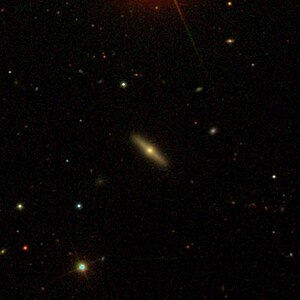NGC 1007
| Galaxy NGC 1007 |
|
|---|---|

|
|
| SDSS recording | |
| AladinLite | |
| Constellation | whale |
|
Position equinox : J2000.0 , epoch : J2000.0 |
|
| Right ascension | 02 h 37 m 52.265 s |
| declination | + 02 ° 09 ′ 22.06 ″ |
| Appearance | |
| Morphological type | Pec |
| Brightness (visual) | 15.8 mag |
| Brightness (B-band) | 16.8 likes |
| Angular expansion | 0.6 'x 0.2' |
| Position angle | 48 ° |
| Surface brightness | 13.3 mag / arcmin² |
| Physical data | |
| Affiliation | WBL 081 |
| Redshift | 0.023590 ± 0.000083 |
| Radial velocity | 7072 ± 25 km / s |
|
Stroke distance v rad / H 0 |
(317 ± 22) x 10 6 ly (97.1 ± 6.8) Mpc |
| history | |
| discovery | Albert Marth |
| Discovery date | January 15, 1865 |
| Catalog names | |
| NGC 1007 • PGC 9967 • CGCG 388-069 • MCG + 00-07-059 • 2MASX J02375226 + 0209220 • GC 5260 • GALEX ASC J023752.41 + 020924.3 | |
NGC 1007 is a lenticular galaxy of the Hubble type S0 / a? in the constellation whale south of the ecliptic . It is an estimated 317 million light years from the Milky Way and about 55,000 light years in diameter.
In the same area of the sky are u. a. the galaxies NGC 1004 , NGC 1008 , NGC 1016 , IC 241 .
The object was by astronomer Albert Marth using on January 15, 1865 a 48-inch - telescope discovered and later by John Louis Emil Dreyer first in the Supplement to the General Catalog of Nebulae and Clusters and then in a row in New General Catalog lists.
literature
- * Mahdavi, Andisheh; Geller, Margaret J. (2004): A Redshift Survey of Nearby Galaxy Groups: The Shape of the Mass Density Profile ; The Astrophysical Journal , Vol. 607 (1), pp. 202-219
Web links
Commons : NGC 1007 - collection of images, videos, and audio files
